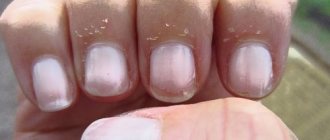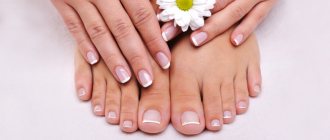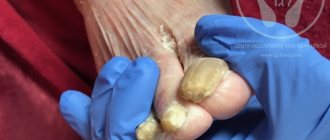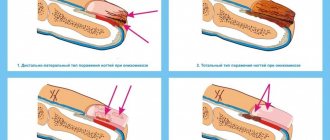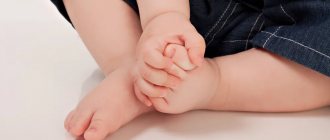- Symptoms
- The initial stage of toenail fungus (photo)
- The initial stage of fingernail fungus (photo)
- Treatment of the initial stage of onychomycosis
- Prevention
The initial stage of nail fungus on the toes and fingers has the same symptoms. Unfortunately, not everyone pays attention to them, which leads to aggravation of the pathological process.
Unpleasant cosmetic defects in the future threaten complete loss of nails and blood poisoning. To prevent these complications, it is important to diagnose and begin treatment of onychomycosis at the very beginning of the disease.
Where can you get infected with onychomycosis?
As noted above, this pathology relates to an infectious disease. The fungus penetrates the nail structure from the external environment. Where can you catch onychomycosis?
The sources of infection are considered to be:
- Infected person. Some types of fungal microflora can parasitize not only the human body, but also exist on personal hygiene items and shoes. As a result, short-term contact can introduce a negative microorganism;
- Pets. In nature, there are more than a hundred species of fungi that can be transmitted from animals to humans;
- Public baths, saunas and swimming pools. Some types of fungal infection are able to reproduce without using living organisms. To become infected with pathogenic microorganisms, it is enough to visit public places with high humidity.
Preventive measures
You can protect yourself from re-infection with onychomycosis if you strictly follow preventive measures.
First of all, this concerns the rules of personal hygiene:
- Wash your feet every day, especially during the hot season;
- Use only your own towel and do not lend it to anyone;
- Do not walk barefoot in public places, including on the beach;
- Thoroughly disinfect pedicure tools, visit trusted beauty salons;
- Do not try on someone else’s shoes; after trying them on in a store, treat your feet with an antifungal agent.
It should be remembered that the detection of onychomycosis in one of the family members is a reason for all household members to strengthen preventive measures, as well as pay attention to disinfection of the house, especially carpets.
Even in the absence of alarming symptoms, you should treat your shoes monthly with antifungal agents: it is much easier to prevent nail fungus than to spend several weeks on unpleasant and expensive treatment.
What factors provoke the development of onychomycosis?
- Age group 60+;
- Diabetes;
- Thrombophlebitis of the lower extremities;
- Weak immunity. The presence of chronic diseases negatively affects the general condition as a whole;
- Uncomfortable shoes made from synthetic materials.
Prevention
To minimize the risk of contracting mycosis, you must follow some rules:
- Practice good hygiene and wash your hands frequently.
- Use your own towel and manicure accessories.
- Strengthen immunity.
- Do not use false nails or apply acrylic nails.
- Treat your nails with iodine or hydrogen peroxide.
- Dry skin thoroughly.
Compliance with all doctor’s instructions and regular use of medications will allow you to completely cure fingernail fungus within 6–12 months. Pathology is treated faster on the hands, since they are open and do not have such a humid and warm environment as the feet.
How does the fungus manifest itself?
In the initial stages of the disease, the fungus does not cause much discomfort. The deformation is reflected in the external state of the nail plate. Numerous spots and grooves of unusual color appear on its surface.
Identify several stages of the fungus. They include:
Infection. A fungal infection is fixed on the surface of dead skin scales. Gradually, microorganisms penetrate the horny epithelium of the nail plate.
Normatrophic. In this case, the nail gradually begins to fade. Its surface acquires a yellowish tint. This phenomenon indicates destruction of the structure of the nail plate.
The fungus feeds on tissues and nutrients. Over time, the nail plate begins to rotate around the edges. The patient develops an unpleasant odor and a burning sensation.
Hypertrophic. In this case, the yellowness completely covers the entire area of the nail. Transverse inclusions are observed along the perimeter of the plate. The nail becomes thick and loose to the touch.
Atrophic. The plate begins to crumble upon contact. As a result, the nail bed remains unprotected.
Onycholysis. This form is considered the most neglected of all listed. If the matrix was damaged during the disease, then the nail will not grow back in the future. The photo of nail fungus shows the degree of damage to the horny epithelium.
Normotrophic type
Types of Nail Fungus
If the disease follows the normotrophic type, the nails have little external change for a long time. Usually only the edges of the nail thicken and slightly change their appearance, and the patient, especially if he uses decorative varnish, does not notice these changes. However, despite the ease of this type of disease, it has its hidden disadvantages. First of all, this is lost time. The patient delays treatment, hoping that such minor changes will go away on their own, but this leads to the fact that the fungus actually spreads quite strongly, penetrates under the nail, and causes inflammation. As a result, in order to cope with this fungus, you have to undergo long-term and not always harmless treatment for the entire body as a whole.
Diagnosis of the disease
If any changes are detected on the surface of the nail plate, it is recommended to seek medical help. The specialist will prescribe a series of procedures to accurately determine the type of fungus and the extent of damage to the nail bed. The patient must first undergo a series of tests:
Microscopy. A scraping is taken from the surface of the affected nail from the infected person. The only drawback of this diagnostic method is the impossibility of accurately determining the type of fungus.
Cultural diagnostics. The taken material is placed in Sabouraud's nutrient medium. This composition promotes the rapid growth and development of fungus in laboratory conditions. After this, the pathogen is distinguished by its color pigment, its growth rate and the type of colony.
This method has good sensitivity to various medications. After 5 days, the patient is given the results of the study, according to which the appropriate treatment is selected.
DNA test. This method allows you to detect the genetic code from a fungal infection. To do this, the scraping is studied for several days and its predisposition to the genus dermatophytes or candida.
What to do at the first signs?
If a person suspects the presence of a fungus, the first thing to do is consult a dermatologist. Diagnostic measures will play a decisive role in therapy. The doctor must determine not only the fact of infection itself, but also determine the type of pathogen. Only on the basis of these data it is necessary to select medications so that they produce a positive effect and suppress the vital activity of specific types of fungi.
The diagnostic examination consists of two stages:
- initial visual inspection;
- taking a microscopic examination and inoculating fungi into cultures.
It is the second method that makes it possible to accurately determine the type of pathogen.
Medical therapy
We present several proven remedies for nail fungus that allow you to get rid of parasitic microorganisms in a short period of time. You should not delay treatment to preserve the structure of the nail plate and prevent its further deformation.
The course is calculated individually based on test results and the stage of nail damage. On average, it ranges from 30 to 70 days from the date of diagnosis.
Folk remedies for nail fungus are to use:
Soda. To do this, place 5 tablespoons of soda and 100 g of laundry soap in a deep container with warm water. It is necessary to steam the lower and upper limbs in this liquid for 30 minutes. During this time, the alkaline composition will help destroy up to 50% of pathogenic microflora.
Treatment of the nail plate with a soft nail file. It will allow you to get rid of the upper affected layer, thereby improving the processing process. After this, the surface of the nail plate is treated with juice from the celandine herb. However, it is worth noting that after such application the nail will acquire a dark black tint.
The previously damaged surface is treated with antiseptic compounds, which will prevent further infection of the damaged nail.
When treating with traditional methods, it is necessary to monitor the condition and appearance of the horny epithelium. If no changes are observed after 14 days, there is no point in further home therapy.
To destroy parasites, you will need to use medications that have antimicrobial and antifungal effects. It is worth noting that the dosage of the active substance should be selected by the attending physician. When calculating the required amount, the specialist will take into account the condition and degree of damage to the nail plates.
Features of onychomycosis on the hands caused by yeast-like fungi of the genus Candida
The second most common lesions of fingernails after dermatophytes are yeast-like fungi of the genus Candida. The incidence of damage according to European researchers ranges from 40 to 60%. Among yeast-like fungi, in 90% of cases the cause of the disease is Candida C. albicans, much less often - C. tropicalis, C. parapsilosis and C. guilliermondii.
Nail plates are 3 times more likely to be affected by Candida fungi in women whose profession is related to cooking and confectionery production, and cannery workers. Predisposing factors are trauma, maceration, high humidity, wearing false nails, diseases that weaken the immune system, diabetes and vascular diseases.
The disease begins with inflammation of the posterior periungual fold, which swells, the skin over it becomes hyperemic, thins and becomes shiny. The nail skin disappears. The edge of the nail fold hangs over the nail plate. When pressed, pus of a crumbly consistency is released from under it. Gradually, the lateral ridges become involved in the inflammatory process, and the pain becomes severe and throbbing. The areas of the nail corresponding to the nail folds become soft, acquire a white, brownish-brown or green color, and gradually separate from the nail bed. Wave-like transverse grooves form on the nail plate. In some cases, the nail plate becomes thinner and is rejected, which is observed when fungi penetrate into the matrix and nail bed. The disease tends to be chronic.
Onychomycosis on the hands occurs with chronic candidiasis. The disease begins in childhood. The leading cause of mycosis development is hereditary immune disorders. Nails become significantly thicker with the disease. The inflammatory process is weakly expressed. The nail skin is preserved. The fingers at the ends become like drumsticks.
Candidal paronychia should be distinguished from psoriasis, lichen planus, eczema, pyococcal paronychia, nail damage due to rubromycosis, onychomycosis, trichophytosis and mold mycoses.
Rice. 27. Candidiasis begins with inflammation of the posterior nail fold.
Rice. 28. Damage to the periungual fold and fingernails due to candidiasis.
Rice. 29. Onychomycosis on the hands with chronic candidiasis.
Rice. 30. Candidal onychomycosis on the hands of a child.
Rice. 31. Wearing false nails contributes to the development of onychomycosis on the hands.
Photo of nail fungus
Treatment
Treatment for yeast fungus on toenails should begin when the first signs of the disease begin to appear. Otherwise, the progression of the disease can provoke damage to the deep layers of the skin and soft tissues.
To avoid negative consequences, the doctor determines the treatment tactics. Taking medications and using traditional medicine should also be carried out under his strict supervision.

